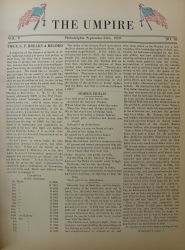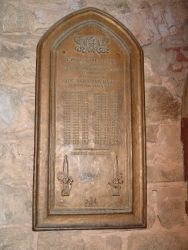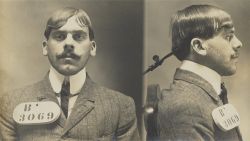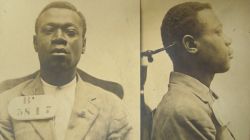



Eastern State Penitentiary—opened in 1829 and closed in 1970—operated throughout nearly every major conflict in modern American history: the Civil War, World Wars I and II, and the Vietnam War. The inmate population mirrored a typical military population—in large part made up of young working class men.
Although the number of persons with criminal records who served during World War I is unknown, we know that more than 100 former inmates of Eastern State Penitentiary in Philadelphia did serve. Despite being imprisoned behind 30-foot high walls, the inmates at Eastern State remained well informed about the war, publishing news and letters from the Front, pining for greater opportunities for participation, and mirroring outside civilian contributions to the war effort.
A 1917 story in Philadelphia’s Evening Bulletin described the bustling activity behind the walls. Through the Honor and Friendship Club, a prisoner benevolent and social society, incarcerated men petitioned Warden Robert McKenty for a “chance to do a bit for the country.” Their wish was granted, and an auxiliary of the Red Cross was organized at the prison. Eastern State prisoners went to work rolling bandages and making slings for the troops. [1]
In the meantime, inmates maintained window boxes—miniature war gardens—throughout the various corridors of the prison. A typical box contained a pumpkin plant, three tomato stalks, and a patch of lettuce. “In all the open spaces between the buildings, the land has been planted in gardens,” the Bulletin reported. “Every available foot of land within the penitentiary walls is being utilized for gardens. On the roofs are many more carefully tended vegetable plots.” [2]
The monthly inmate newsletter, The Umpire, reported regularly on the war, reprinting war-themed addresses from the likes of President Woodrow Wilson, reporting on how draft laws affected prisoners, and recording inmates’ contributions to the war effort. [3]
The inmates purchased war bonds and raised funds for soldiers and sailors. An article from The Umpire in 1918 boasted that its “War Chest” week met with great success. Prisoners gave nearly $4,000 toward the war effort. The Umpire extolled:
"They did their “bit” that day, and […] proved themselves Americans to the core, by an example of unselfish sacrifice which, were it universally copied without these walls, would go far towards the winning of this war.
Every man of them knows that it is only by such giving that we, who may neither fight nor work for the country that we love better than life itself, can do it service. […] the givers have surely earned all honor, have shown themselves Americans, and men; have been shown themselves to be worthy of a better giving […] perhaps of life itself, to that Country for whom they are now doing all that is possible."[4]
The Umpire later reported that the inmates financed the purchase of an ambulance for the Red Cross, amassing an additional $1,600 in a three-hour event. [5] It is particularly noted that the women incarcerated at Eastern State donated an average of $5 each toward the effort. [6] (The average inmate in 1918 was probably earning about $8 a month.[7]) Additionally, inmates produced games (one was called “Go-Bang”), cut bathrobes, and knitted dozens of sweaters and socks for the soldiers. [8]
Still, these extraordinary contributions did not seem to satisfy the inmates’ desire to serve in the war. Eastern State inmates practiced elementary drill tactics and repeated their appeals to join the war effort outside of the prison walls. [9] The Umpire is filled with editorials asking for early paroles and pardons for inmates wishing to serve in the military, one stating:
"A great majority would gain self-respect and courage and hope from the idea they were doing something to help win the war.
Prisoners by and large have been one of our notable failures. We have punished them for a fault and generally turned them out in a condition where they were less competent to avoid faults than when they went in. The common effect of prison regimen has been to mark men off and shut them out from their fellowmen. This war raises the gregarious instinct, the impulse to fellowship, to its greatest height.
Prisoners are entitled to take their share in the common lot and participate consciously in the fate of their country. They are entitled to feel that they are doing something to help win the war. Wherever it can possibly be managed they should be put at work that has a tangible connection with the war." [10]
Although there is limited historic evidence, the inmates’ pleas to serve seem to have finally fallen on receptive ears. Warden Robert McKenty stated that men were indeed paroled so that they could serve in the military. When they returned from the war, the Evening Bulletin wrote, “they brought wound stripes, service bars, honorable discharges, a boxful of decorations, sergeants’ and corporals’ chevrons (insignias).” Their service was framed as “winning back their citizenship” and “making good” after their trouble with the law. At least one former prisoner noted the dissonance between the sanctioned assaults of war and the outlawed violence that landed him in prison. “One who returned wounded and covered with medals,” McKenty wrote, “confided to me that, ‘Here he was doing eight to fifteen years for manslaughter, yet was rewarded for killing over there.’” [11]
A few years after the war had ended, the prison’s Board of Inspectors presented a bronze plaque to the penitentiary. It listed the inmate numbers of 118 men who served in the Army and Navy during the war. In a formal ceremony attended by Philadelphia Mayor J. Hampton Moore and Congressman J. Washington Logue, the penitentiary band played while officials praised the men for their ability to “go straight” when given the opportunity to serve. [12] An inmate reportedly designed the plaque, which was hung in the prison’s center surveillance hub (where it still hangs today). [13]
Of the 117 men listed on the plaque who served and survived the war, at least three are known to have returned to Eastern State for additional convictions, all for larceny or robbery. This is significantly less than the approximately 50% recidivism rate during the time period. [14] However, without a great deal of additional research, we cannot know to what extent the former inmates of Eastern State made good at the Front. And did they “make good” on the rest of their lives outside the walls? Until we know more, we can only appreciate the altruistic spirit of those prisoners, making a few cents an hour, who were able and willing to help others less fortunate than themselves and who fulfilled their promises of service upon release. Perhaps, based on their examples, we can also reevaluate the possibilities for those incarcerated in the United States: the country with the largest prison population in the world.
-----------------------------------------------------------------------------------------------------------------------------------
NOTES:
1. “Convicts Working to Aid Red Cross,” Evening Bulletin, June 30, 1917.
3. "Prisoners May Be Drafted,” The Umpire, June 20, 1917.
4. “‘War Chest’ Week a Great Success—Inmates Give Nearly Four Thousand Dollars,” The Umpire, June 5, 1918.
5. “The E.S.P. Breaks a Record,” The Umpire, September 25, 1918.
6. Both men and women were housed at Eastern State until 1923, when it became a men’s facility.
7. Inmate earning data is unavailable for 1918. Estimates were compiled using the Annual Report of the Eastern State Penitentiary for the Year Ending May 31, 1925.
8. “‘Go-Bang’ from Prisoners to Soldiers,” The Umpire, July 23, 1918; Untitled, The Umpire, June 26, 1918.
9. “They Give Their Money and Offer Their Lives,” The Umpire, June 5, 1918.
10, “Why Not Utilize Prisoners?,” The Umpire, June 26, 1918.
11. “Cites Convicts’ War Record,” Evening Bulletin, date unknown.
12. Robert McKenty, Warden’s Daily Journal, December 19, 1922; “121 Ex-Convict War Heroes Paid Honors,” The Philadelphia Inquirer, December 20, 1922.
13. “Convicts! But They Fought For U.S., So Honor Is Theirs,” Public Ledger, December 20, 1922.
14. These numbers, found on page 62 of this document, are for state prisoners for 1923, the closest year to WWI with available recidivism data. United States Department of Justice, Bureau of Justice Statistics. (1986). Historical Corrections Statistics in the United States, 1850-1984, by Margaret Werner Cahalan with Lee Anne Parsons. Retrieved from the National Criminal Justice Reference Service web site: https://www.ncjrs.gov/pdffiles1/pr/102529.pdf


